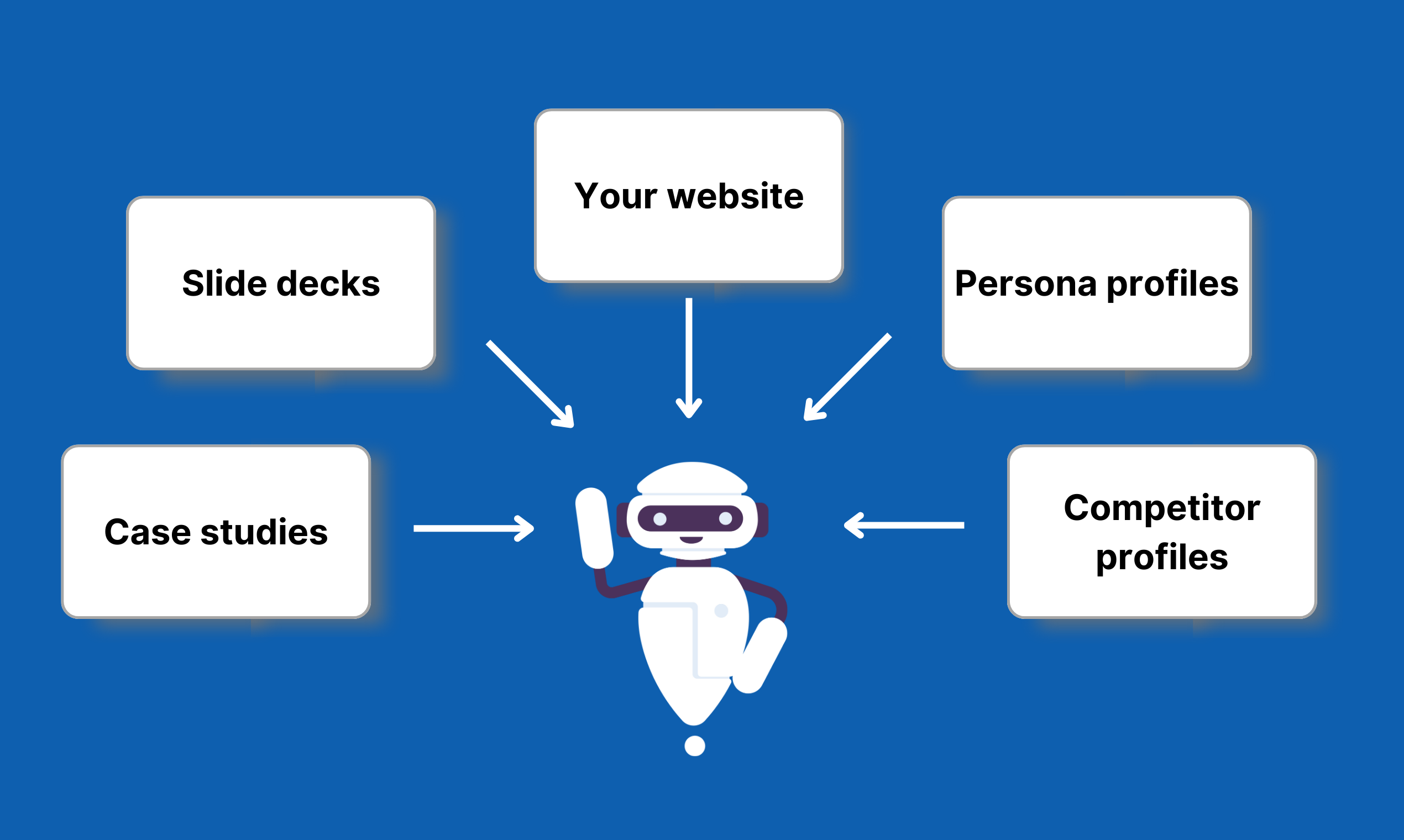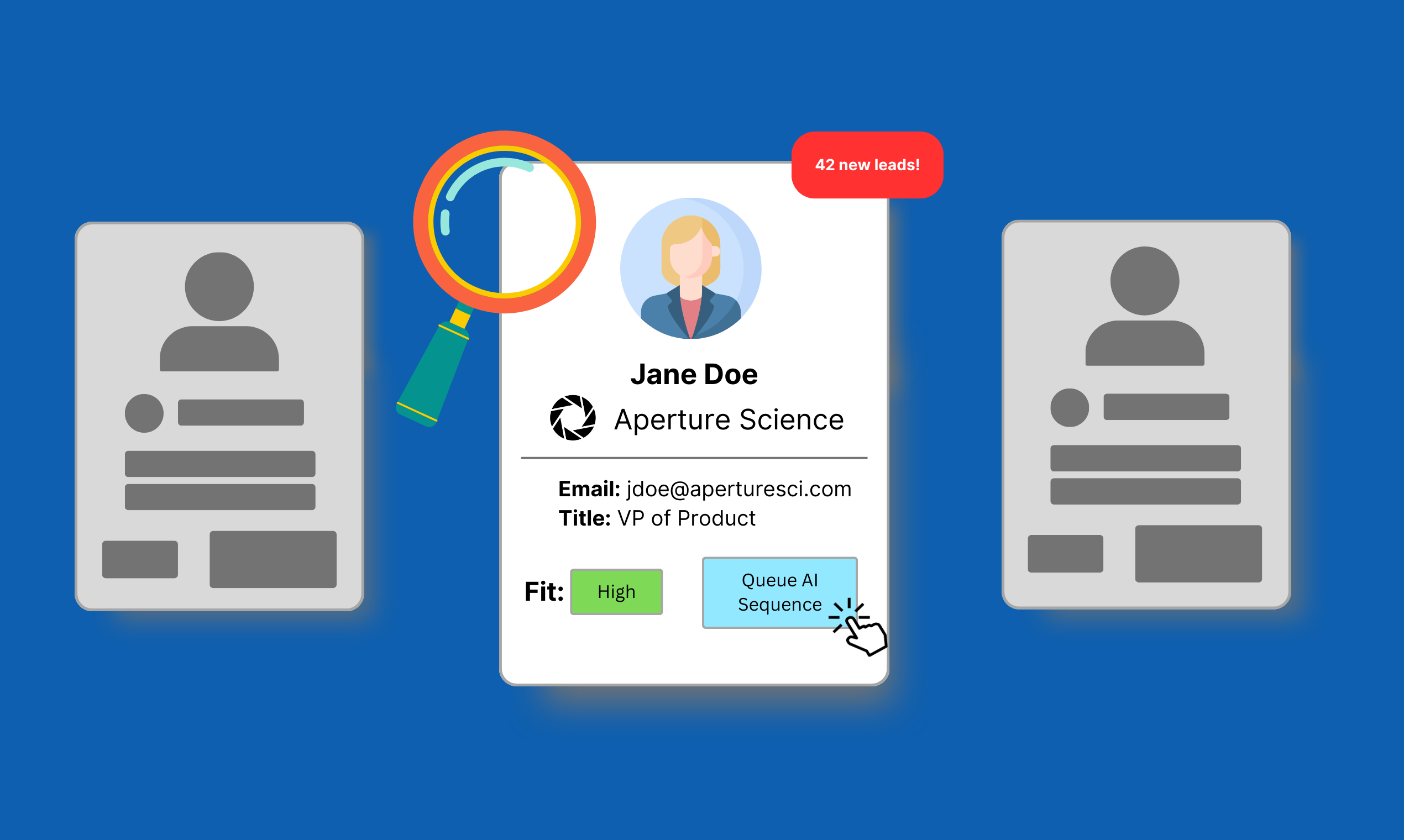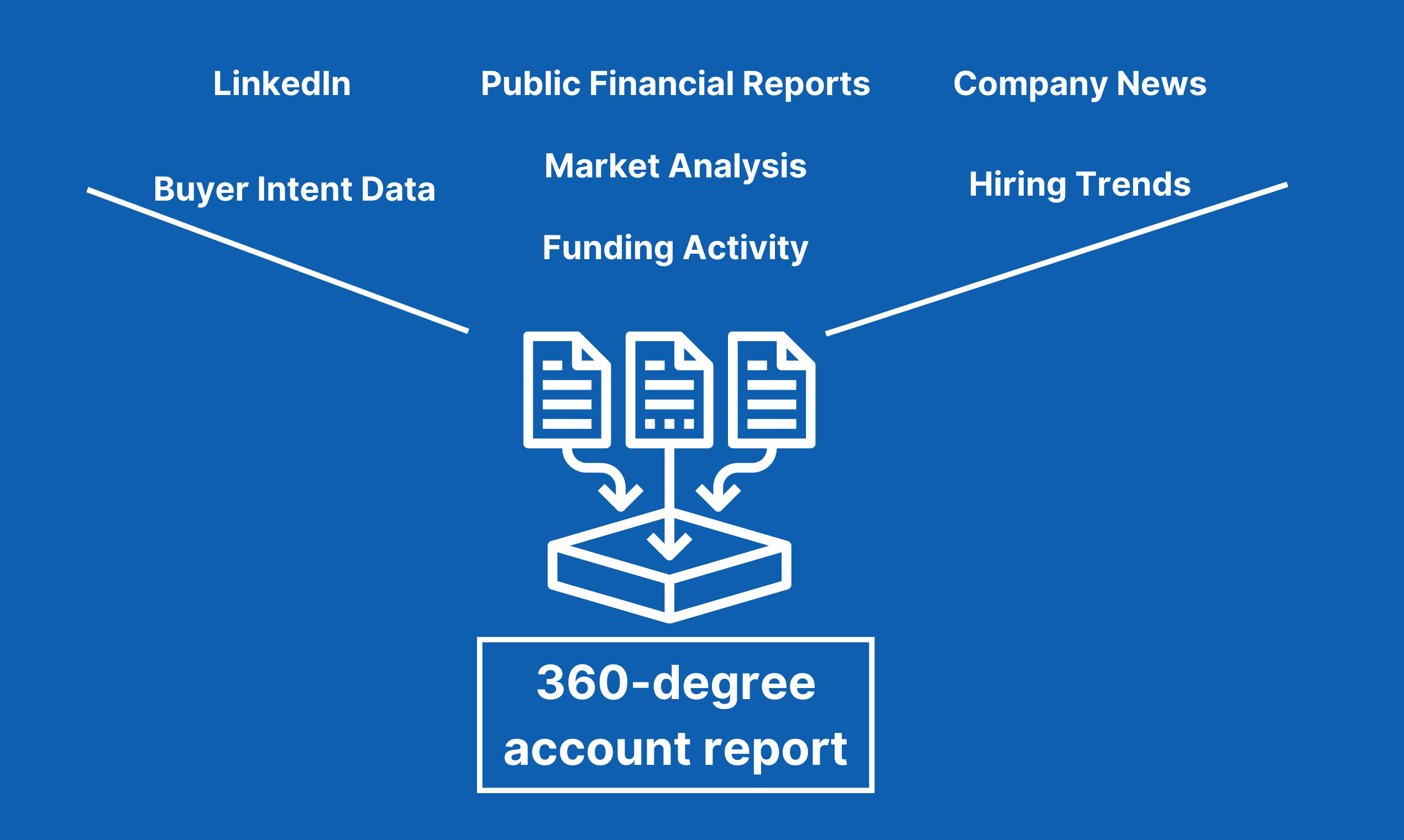![The Ultimate Guide to Prospect Research [Winning Protocol in 2024] The Ultimate Guide to Prospect Research [Winning Protocol in 2024]](https://cwequliwcnbjfebristt.supabase.co/storage/v1/object/public/assets/blog/custom-covers/abstract-8.jpg)
B2B markets are more competitive than ever, making successful client prospecting a pillar of business growth and long-term success. However, most organizations lack scalable processes for qualifying and converting prospects efficiently.
This guide will walk through everything you need to know about prospect research in 2024, with a focus on tactics and tools built for companies selling products and services in the B2B space. We'll cover how to define your ideal customer profile, locate data sources, leverage automation, and more.
By the end of this guide, you will not only have a deep understanding of the concepts behind effective prospect research, but also be equipped with an actionable toolkit of cutting edge prospect research protocols for 2024.
What is a prospect?
A prospect refers to any company, organization, or individual decision-maker that fits the criteria of your ideal customer profile (more on this in a bit) and could plausibly become a future customer. Prospects have not been qualified through direct interaction yet, but show potential based on their attributes and demographics.
Prospects vs leads
Many new sellers get confused about terminology. The distinction between prospects and leads is minor but important because each requires different sales and marketing workflows to manage effectively.
A prospect is an account or contact that appears to match your target buyer profile based on available data like company size, industry, location, technologies used, etc. They have received no direct marketing yet.
A lead is a prospect that has been qualified as having active interest and an increased likelihood of buying based on behaviors like website visits, content downloads, form submissions, etc. Leads receive direct sales/marketing outreach.
Why should you research prospects?
Prospect research can be time consuming, and most people you speak to will not end up becoming paying clients. It’s natural to ask why you should bother researching them at all. It turns out that doing the work on the front end to understand the objectives and challenges faced by your prospects will significantly improve your win rates and quota attainment.
Per LinkedIn, 82% of top performers say they perform research “all of the time” before reaching out to prospects. 49% of salespeople who didn’t achieve the highest performance level say they perform research “all of the time.”
Effective prospecting comes down to 3 core ideas, which are all the result of in-depth research.
- Personalization
- Prioritization
- Credibility
Personalized outreach: Tailor your marketing strategies to address the specific needs and pain points of your ICP
Incorporating personalization into your prospect outreach and marketing not only fosters a sense of value and understanding among prospects but also significantly improves business outcomes, such as outreach response rates and deal win rates. In order to personalize your sales content, you need to know what motivates your prospects.
Utilizing data from first, second, and third-party sources allows for the creation of personalized communications. This approach tailors messaging to each prospect's unique needs and interests, increasing the likelihood of engagement and conversion. Personalized emails, for instance, can leverage cold email software for targeted messages, with automated sequences enabling personalized outreach at scale.
Account-Based Selling is all the rage right now because it is proven to deliver superior results for enterprise and mid-market revenue organizations. However, ABS and Account-Based Marketing (ABM) would not be possible without research and data. These are multi-channel, multi-touch strategies that target multiple prospects within a company with tailored content, messaging, and value propositions. These methods helps in establishing company-wide relationships and guiding qualified prospects through the sales funnel, significantly improving conversion rates and building long-term business relationships.
By focusing on personalized communications, tailored content, and data-driven strategies, companies can enhance their prospecting efforts, leading to increased engagement, higher conversion rates, and sustained business growth.
Prioritize leads that fit your ICP to ensure marketing efforts are directed towards the most promising prospects
Identifying Your Ideal Customer Profile (ICP) is a pivotal step in successful client prospecting and entails creating a detailed description of the account that represents your dream lead or client. This process is crucial for focusing efforts on leads most likely to convert into successful acquisitions, thereby streamlining the sales process and enhancing efficiency.
Key Components of an ICP
- Industry & Location Pinpoint the specific industries and geographical locations where your ideal customers operate.
- Company Attributes Include firmographic details such as the number of employees, annual revenue, and the technology stack currently in use.
- Needs & Pain Points Identify the primary challenges your ideal customer faces that your product or service can solve.
- Goals & Objectives Understand the short-term and long-term goals of these companies to align your offerings accordingly.
To build an effective ICP, start by analyzing your existing customer base to identify common attributes among your best customers. This involves reviewing customer feedback, assessing the types of companies that gain maximum value from your products or services, and regularly updating your ICP as your business and market evolve.
Use research to find prospects that match your ICP
Identifying and engaging qualified prospects that align with predetermined buyer personas enables businesses to develop long-lasting client relationships and a robust sales pipeline.
Many datapoints that you can use to qualify prospects can be found in databases such as ZoomInfo and LinkedIn Sales Navigator. However, other crucial information about your prospects’ needs and goals can only be found by conducting in-depth research into your prospective clients by reading news articles, market analysis and even company financial reports.
Qualifying your prospects takes time, but diligent commitment to client research will lead to higher win rates and increased overall sales efficiency.
Build trust and credibility with prospects from the very first meeting
By making prospects feel valued and understood, personalization fosters customer loyalty and trust. This is achieved through relevant and personalized emails, phone calls, meeting agendas, and other outreach efforts. Such personalized interactions not only cut through the noise in a saturated market but also position your business as a trusted advisor, creating competitive differentiation and enhancing credibility.
Trust and credibility might seem like nebulous ideas, but the data backs up their importance. According to Salesforce, 87% of business buyers expect sales reps to act as trusted advisors. However, 63% of 1,200 executives surveyed in a different study said that understanding customer needs is a significant challenge.
Thorough account research, combined with modern account planning practices, enables sellers to approach buyers with expertise and confidence, increasing win rates and forming the foundation of long-lasting relationships.
Leveraging Data and Analytics In Prospect Research
Leveraging data and analytics transforms B2B prospecting from a hit-or-miss activity into a precise, targeted strategy. Here are some best practices for incorporating data into your prospecting efforts.
Maintain Good Data Quality
The foundation of successful B2B prospecting lies in the quality of data used. Accurate, up-to-date, and global data, including phone-verified mobile data and verification services on request, are essential for targeting the right prospects. A commitment to maintaining high data quality standards, with unrestricted access to viewing and page-level exporting of global data, sets a benchmark for the industry.
Segment and Score Prospect Accounts
Data analytics enables the segmentation of prospects based on demographics, behavior, preferences, and needs, allowing for more tailored outreach. Moreover, scoring prospects based on their likelihood to buy, potential value, and urgency can significantly improve the efficiency of B2B sales prospecting. Utilizing predictive analytics to forecast future sales opportunities enables businesses to proactively target high-potential leads. This approach not only streamlines the prospecting process but also increases the chances of conversion.
The strategic use of data and analytics in B2B prospecting not only enhances the precision and effectiveness of outreach efforts but also aligns with legal and ethical standards. By focusing on data compliance, quality, and leveraging insights from analytics, businesses can significantly improve their prospecting outcomes, leading to higher conversion rates and ROI.
Essential Prospect Data for Complete Prospect Research
Business Profile
Understanding key details about the prospect's business is essential for tailoring your pitch and demonstrating knowledge of their organization. Key elements include:
- Headquarters locations - Selling to multinational companies requires awareness of international teams to leverage relationships across markets.
- Leadership team profiles - Even if not selling directly to the C-suite, their priorities significantly influence purchasing decisions and budget allocation.
- Company and department headcount - For usage-based pricing models, knowing the potential user base is critical for accurate opportunity sizing.
- Breakdown of business lines or product offerings - Having a clear picture of each relevant line of business allows you to map how your solution provides value.
- Financials and funding status - Financial performance indicates their growth stage and which areas may receive the most investment.
Business Initiatives
Staying updated on the prospect's key initiatives is paramount for positioning your offering as aligned with their strategic objectives:
- Departments expanding or shrinking - Indicates areas of priority and resource allocation.
- New product/market launches - Signals growth opportunities your solution could support.
- Recently announced partnerships - May uncover complementary offerings to leverage.
- Significant market/financial trends - Impacts investments and prioritization of initiatives.
Decision-Making Team
An in-depth understanding of the human element is just as vital as grasping the business priorities:
- All stakeholders involved in purchasing - Ensures your messaging resonates with each influencer.
- Reporting structures and relationships - Navigating org dynamics increases sale navigation.
- Authority and influence levels - Allows targeting buyers with real decision power.
- Existing connections - Leveraging internal relationships provides credibility.
- Power dynamics and roadblocks - Proactively addressing potential hurdles smooths the process.
Business Challenges
Identifying prospect pain points allows you to position your solution's value proposition as essential:
- Process/technology inefficiencies - Demonstrate how your solution optimizes workflows.
- Financial trends - Appeal to needs like cost reduction or scalable pricing.
- Competitor activities - Differentiate based on competitive advantages.
- Market/tech dynamics - Ensure your solution adapts to evolving landscape.
- Competitor offerings - Arm yourself with strong competitive differentiation.
- Regulatory changes - Highlight compliance capabilities of your solution.
Where to Find Comprehensive Client Prospect Information
In 2024, there are a wealth of options for finding this level of detail on B2B prospects:
- All-in-one research platforms - Aomni makes account-based intelligence actionable. Our account intelligence platform aggregates 100+ data points in a single report that would take an AE over 5 hours to research. The tool empowers you to win more deals by leveraging 360-degree knowledge about your prospects at an individual level.
- Data vendors - Services like ZoomInfo, DiscoverOrg, Dun & Bradstreet, and InsideView that aggregate corporate data for filters and searches.
- Job boards and hiring platforms - Sites optimized for recruitment like LinkedIn, Indeed, Glassdoor reveal insights on growth, open roles, and hiring managers.
- Technographic intelligence - Tools focused on tech stack details like BuiltWith, Datanyze, and HG Insights.
- News and media monitoring - Curated news sources and monitoring tools highlight announcements, PR, thought leadership, and more.
- Website tracking and enrichment - Identify site visitors, track their journey, and enrich their profiles across multiple sessions.
- Social media - Company pages, employee profiles, and content provide a wealth of structured and unstructured data points.
Automate Prospect Research With Aomni
The most effective B2B teams leverage the latest AI, machine learning, and data automation technologies to stay hyper-focused on their ideal prospects without wasting valuable sales and marketing resources. Intelligent systems handle the tedious tasks while humans focus on relationship building and deal strategy.
Automating tedious tasks is key for efficiency at scale. Here’s how we use Aomni ourselves to research customer and client prospects at lightning speed.
Step 1: Train an Aomni AI sales agent that understands the specific solution you sell using your sales collateral.

Step 2: Identify individuals that match your ICP at each prospective client and qualify them according to ICP fit and need.

Step 3: Aggregate 100+ data points from dozens of high-intent prospect data sources and extract insights from sources that are most relevant to your solution.

The Aomni platform makes this data actionable by enabling you to ask deeper strategic questions, draft high-value sales deliverables like custom slide decks, and generate hyper-personalized sales outreach.
Conclusion
Throughout this guide, we've explored the core components vital for successful B2B prospecting—ranging from identifying the ideal customer profile to leveraging advanced digital tools and integrating personalized content marketing for greater engagement. Each element we've discussed plays a crucial role in enhancing the efficiency and effectiveness of your sales process, ensuring that your prospecting efforts are not just informed but also targeted to meet the specific needs and pain points of your potential clients. By adhering to the strategies presented, businesses are better positioned to streamline their sales funnel, improve conversion rates, and ultimately drive substantial growth.
As the landscape of B2B sales continues to evolve, so too must our approaches to prospecting and client engagement. The integration of data analytics, personalization, and digital tools not only provides a competitive edge but also fosters deeper, more meaningful connections with prospects. Remember, the journey toward optimized prospecting is ongoing, and embracing these methodologies can significantly impact your business's success. For those ready to elevate their prospecting game, don’t hesitate to sign up and unlock the potential of a carefully curated, data-driven approach to client acquisition.
FAQs
What are the most effective methods for B2B prospecting?
There are several key methods for B2B prospecting, each with its own strengths:
- Cold calling and emailing - Sales development representatives (SDRs) initiate contact with potential clients they have not previously engaged with.
- Warm calling - This method is used when a prospect has already shown interest in your product or service, making the interaction more personalized.
- Social selling - Leveraging the influence of social media platforms can be a powerful tool in prospecting.
How can you effectively prospect B2B clients?
To successfully prospect B2B clients, consider these strategies:
- Email prospecting - A favored approach due to its various functional benefits over other communication channels.
- Cold calling - A traditional but still relevant technique.
- Social media platforms - Utilize Twitter, LinkedIn, and Facebook to connect with potential clients.
- Webinars - Engage and educate prospects.
- Client referrals - Leverage your current clients to gain new prospects.
- Direct mail - An often-overlooked method that can stand out in the digital age.
What constitutes a B2B prospect list?
A B2B prospect list is a compilation of potential buyers that are identified, contacted, and nurtured with the goal of converting them into customers. This is achieved through various sales and marketing activities, including cold calling, outbound email, content marketing, and pay-per-click (PPC) advertising.
What are the different categories of prospects?
Prospects can generally be classified into three categories based on their priority level:
- High-priority prospects - These are the most promising prospects that are likely to convert and become valuable customers.
- Medium-priority prospects - These prospects have some potential but may require more nurturing before conversion.
- Low-priority prospects - These are the least likely to convert, but they should not be completely disregarded as they might become more valuable over time.